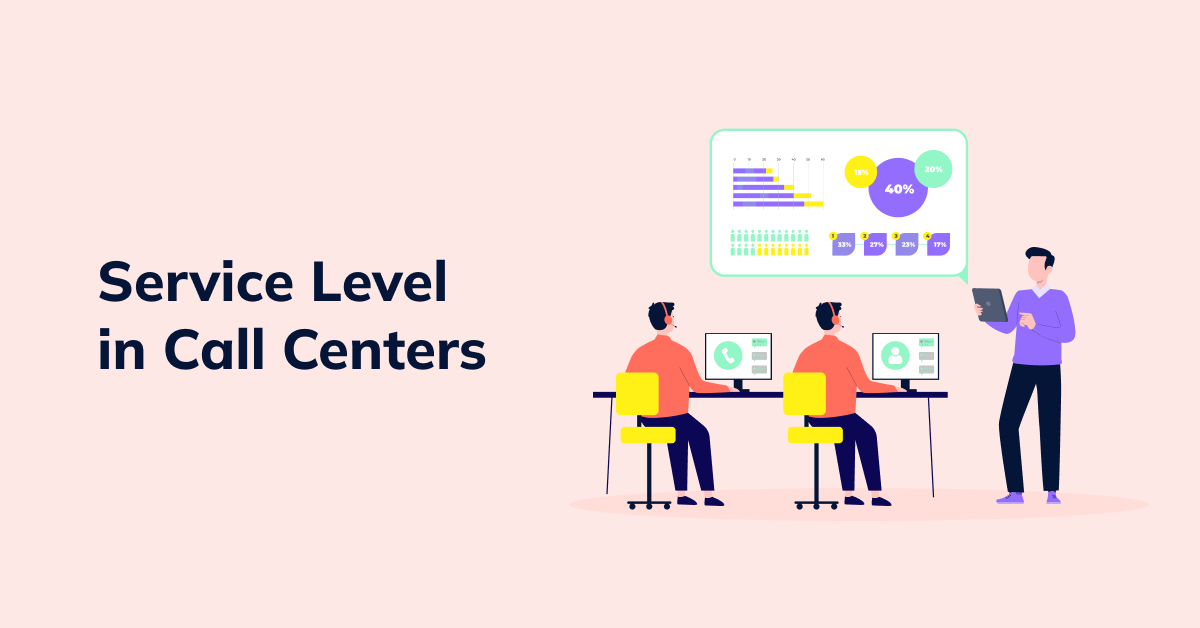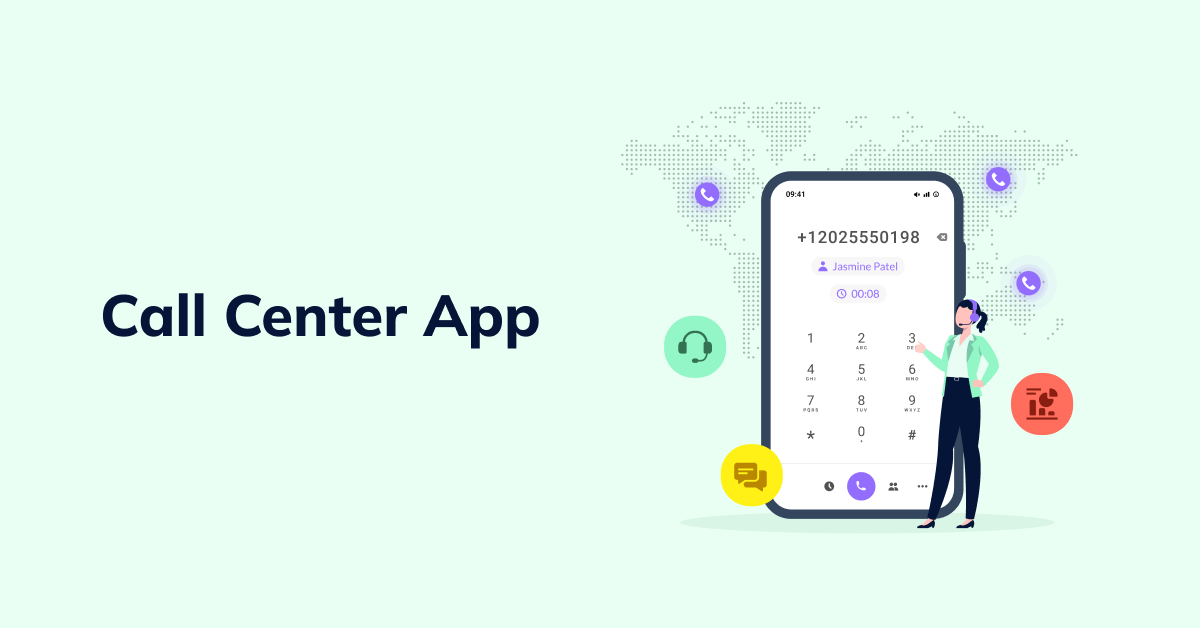Call Abandonment Rate is a critical measure of both customer satisfaction and operational efficiency in the call center environment. This article takes a deeper look into Call Abandonment Rate, how to calculate and monitor it, and provides strategies to reduce it.
Whether you’re a call center manager seeking to improve your team’s performance or a business leader aiming to enhance customer satisfaction, this guide offers valuable insights and practical strategies for using contact center software to help you effectively manage your Call Abandonment Rate.
What is Call Abandonment Rate?
Call Abandonment Rate, also known as the abandon call rate or the abandoned call rate, is a key performance indicator (KPI) in the call center industry. It refers to the percentage of inbound calls abandoned, i.e., terminated by the customer before they are connected to a customer service agent.
Along with other critical metrics like the Average Handle Time, Call Answer Rate, and First Call Resolution, this call center metric helps evaluate the overall performance of a call center.
How to Calculate Call Abandonment Rate?
The calculation of the Call Abandonment Rate is a fundamental process in call center analytics, providing a quantifiable measure of a call center’s efficiency and customer service quality. Here’s a deeper look into how this calculation is performed:
- Identify the Total Number of Incoming Calls: The first step in calculating the Call Abandonment Rate is to identify the total number of incoming calls within a specific period. This includes all calls, regardless of whether they were answered, missed, or abandoned.
- Determine the Number of Abandoned Calls: The next step is to determine the number of calls that were abandoned during the same period. An abandoned call is defined as a call that was terminated by the customer before connecting to an agent. This does not include calls that were missed or dropped due to technical issues.
- Perform the Calculation: Once you have these two numbers, you can calculate the Call Abandonment Rate by dividing the number of abandoned calls by the total number of incoming calls. This will give you a decimal number.
- Convert to a Percentage: To make the rate easier to understand and compare, multiply it by 100. This will convert the Call Abandonment Rate into a percentage.
Call Center Abandonment Rate Formula:

Example of Call Center Abandonment Rate:
Let’s say your call center received a total of 1,000 calls in a day. Out of these, 50 calls were abandoned by the customers before they could be connected to your service representative. To calculate the abandon call rate, you would divide the number of abandoned customer calls by the total number of calls: 50 (abandoned calls) / 1,000 (total calls) = 0.05. Then, to convert this number into a percentage, you would multiply it by 100: 0.05 * 100 = 5%. So, in this example, your call center’s abandon call rate for the day would be 5%.
It’s important to note that while this calculation provides a general overview of the Call Abandonment Rate, it can be further refined by considering additional factors. For instance, you might choose to exclude calls that were abandoned within a certain number of seconds, as these are often the result of misdials or immediate hang-ups that aren’t indicative of customer dissatisfaction. By consistently monitoring the Call Abandonment Rate, call centers can easier identify areas for improvement.
Monitoring Your Call Center Abandonment Rate
Monitoring the Call Abandonment Rate is a crucial aspect of managing a call center. This metric serves as a key indicator of both operational efficiency and customer satisfaction, making it an essential tool for call center management. Here’s how to monitor your Call Abandonment Rate effectively:
1. Regular Tracking
The first step in monitoring your Call Abandonment Rate is to track it regularly. This could be on a daily, weekly, or monthly basis, depending on the size and nature of your call center. Regular tracking allows you to identify trends and patterns, such as peak times for call abandonment, and respond accordingly.
2. Using Analytics Software
Utilizing call center software solutions can greatly enhance your ability to monitor your Call Abandonment Rate and other call center metrics. These tools can automatically track and calculate your Call Abandonment Rate, as well as provide additional insights such as the average time before abandonment, the distribution of abandoned calls throughout the day, and more.
3. Detailed Analysis
Once you have the data, it’s important to analyze it in detail. Look for patterns and trends, such as certain times of day when the Call Abandonment Rate is particularly high or specific agents who have a higher than average rate. This can help you identify potential issues and areas for improvement.
4. Benchmarking
Compare your Call Abandonment Rate to industry standards or your own historical data. This can help you gauge your performance and identify whether your Call Abandonment Rate is within an acceptable range.
5. Actionable Insights
The ultimate goal of monitoring your Call Abandonment Rate is to gain actionable insights. Use the data and analysis to inform your decision-making process. This could involve adjusting staffing levels during peak times, improving training for certain agents, or implementing new strategies to reduce wait times.
By effectively monitoring your Call Abandonment Rate, you can ensure that your call center is operating efficiently and providing a high level of customer service. This can lead to increased customer satisfaction, loyalty, and, ultimately, business success.
What is the Industry Standard for Call Abandon Rate?
The industry standard for Call Abandon Rate varies significantly across different sectors due to the unique nature of customer interactions and expectations in each industry. Here’s a deeper look at the standard Call Abandon Rate in various industries:
- Telecommunications: In the telecommunications industry, the standard Call Abandon Rate typically falls between 5-8%. Given the high volume of calls and the often complex nature of customer queries, a slightly higher abandon rate is considered normal.
- Healthcare: For healthcare providers and medical call centers, the standard Abandon Rate is usually lower, around 3-5%. This is due to the critical nature of many calls, which means callers are more likely to wait for assistance.
- Retail: In the retail sector, the standard Abandon Rate can vary widely depending on the time of year and the specific nature of the retailer. However, a general benchmark is around 5-7%.
- Financial Services: For banks and other financial institutions, the standard Abandon Rate is typically around 5%. This reflects the importance of the calls and the expectation of high-quality customer service.
- Travel and Hospitality: In the travel and hospitality industry, the standard Abandon Rate can be higher, often around 7-9%. This is due to the high volume of calls and the often complex nature of customer queries.
- IT and Software Services: In the IT and software services industry, the standard Abandon Rate is typically lower, around 4-6%. This reflects the technical nature of many calls and the expectation of expert assistance.
It’s important to note that these are general benchmarks, and the acceptable Call Abandon Rate can vary depending on the specific circumstances of each call center. However, regardless of the industry, a high call center Abandon Rate is often a sign of underlying issues that need to be addressed.
Common Reasons for Abandoned Calls in a Call Center
Call abandonment is a common issue in call centers, and understanding the reasons behind it is crucial for effective contact center management. Here’s a more detailed exploration of why calls are abandoned in a call center:
1. Long Wait Times
This is perhaps the most common reason for call abandonment. When customers are kept waiting for too long, they may become frustrated and hang up. The threshold for what constitutes a “long” wait time can vary depending on the nature of the call and the customer’s expectations.
2. Inadequate Staffing
If there are not enough agents available to handle the volume of incoming calls, customers may be forced to wait and eventually abandon the call. This is often an issue during peak call times or when there is an unexpected surge in call volume.
3. Poor Call Routing
If calls are not routed efficiently to the appropriate agent, service level, or department, customers may end up waiting longer or being transferred multiple times, leading to call abandonment.
4. Lack of Self-Service Options
In some cases, customers may abandon calls if they are unable to find the information they need through self-service options. This could include automated menus, website information, or chatbots.
5. Technical Issues
Technical problems, such as poor call quality or dropped calls, can also lead to call abandonment. These issues can be particularly frustrating for customers and may damage their perception of the company.
6. Lack of Callback Options
If customers are unable to request a callback and are forced to wait on hold, they may choose to abandon the call instead. Offering a callback option can significantly reduce call abandonment rates.
Understanding the reasons behind call abandonment can help call centers develop effective strategies to reduce their Call Abandonment Rate and improve customer satisfaction. By addressing these issues proactively, call centers can enhance their efficiency and deliver a better customer experience.
How to Avoid Call Center Abandonment Rate
Avoiding high call center abandonment rates requires a strategic approach that addresses the root causes of call abandonment. Here’s a deeper dive into strategies that can help reduce call abandonment rate call center:
1. Efficient Call Routing
Implementing an efficient call routing system ensures that calls are directed to the most appropriate agent or department, reducing wait times and improving customer satisfaction. Advanced systems can even route calls based on the caller’s history or specific needs.
2. Optimizing IVR menu
Complicated IVR menus that are confusing and difficult to navigate can make it challenging for customers to get through to a live agent, leading to negative customer experiences and more abandoned calls. Making your IVR menu more intuitive, user-friendly, and easy to navigate is essential to reducing call abandonment rates.
3. Adequate Staffing
Ensuring your call center or customer support team is adequately staffed, especially during peak hours, is crucial. This might involve hiring more support agents, offering overtime, or using part-time or remote workers to handle extra call volume.
4. Training and Development
Regular training can help agents handle calls more efficiently and effectively, reducing the likelihood of call abandonment. This could include training in customer service skills, product knowledge, or problem-solving techniques.
5. Implementing Callback Options
Offering a queue callback option can significantly reduce call abandonment rates. Instead of waiting on hold in long call queues and wasting time, customers can choose to receive a call back when an agent becomes available.
6. Investing in Technology
Advanced call center technologies, such as AI and machine learning, can help predict call volumes more accurately, optimize staffing levels, and identify patterns that lead to call abandonment.
7. Enhancing Self-Service Options
By improving your self-service options, such as automated menus or online FAQs, you can help customers find the information they need without having to wait for an agent.
8. Regular Monitoring and Analysis
Regularly monitoring your Call Abandonment Rate and analyzing the data can help you identify issues and implement corrective measures before they become major problems.
By implementing these strategies, you can avoid high call center abandonment rates and ensure a more positive experience for your customers. This not only improves customer satisfaction but also enhances the overall efficiency and effectiveness of your call center.
Conclusion: The Importance of Call Abandonment Rate
In the dynamic landscape of customer service, the Call Abandonment Rate stands as a pivotal metric that can significantly influence a call center’s performance and reputation. Combined with other metrics like Customer Satisfaction Score (CSAT) and Customer Effort Score (CES), it helps call centers evaluate the overall customer experience and satisfaction.
A high Call Abandonment Rate often signals underlying issues such as long wait times, inadequate staffing, or inefficient call routing, all of which can lead to poor customer service, dissatisfaction, and potential loss of business. Conversely, a low Call Abandonment Rate typically indicates efficient operations and high customer satisfaction, contributing to customer loyalty and positive word-of-mouth.
Moreover, understanding and managing the Call Abandonment Rate can provide valuable insights for strategic decision-making. It can guide resource allocation, inform staff training programs, and help evaluate the effectiveness of various strategies and technologies.
In essence, the Call Abandonment Rate is not just a number but a powerful tool for enhancing customer service, improving operational efficiency, and driving business success. Therefore, monitoring and managing this crucial metric should be a top priority for any call center committed to delivering exceptional customer service.



